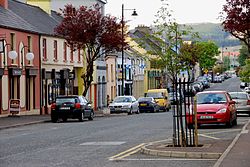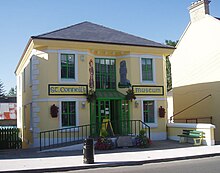
Letterkenny, nicknamed the Cathedral Town, is a large town in County Donegal, Ireland, on the River Swilly in the north-west of Ulster. Along with the nearby city of Derry, Letterkenny is a regional economic gateway for the north-west of Ireland.

Ardara is a small town in County Donegal, Ireland. It is located on the N56 and R261 roads. The population as of the 2016 census was 732. The population of 731 at the 2011 Census represented an increase of about 30% since 2006. In 2012, The Irish Times named it the best village in which to live in Ireland.
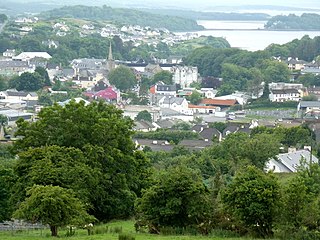
Donegal is a town in County Donegal in Ulster, the northern province in Ireland. Although Donegal gave its name to the county, now Lifford is the county town. From the 15th until the early 17th century, Donegal was the "capital" of Tyrconnell, a Gaelic kingdom controlled by the O'Donnell dynasty of the Northern Uí Néill.

Stranorlar is a town, townland and civil parish in the Finn Valley of County Donegal, in Ireland. Stranorlar and Ballybofey form the Twin Towns.

Ballybofey is a town located on the south bank of the River Finn, County Donegal, Ireland. Together with the smaller town of Stranorlar on the north side of the River Finn, the towns form the Twin Towns of Ballybofey-Stranorlar. Ballybofey-Stranorlar, a census town, had a population of 4,852 in 2016.
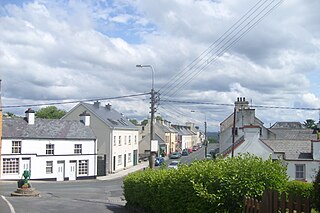
Mountcharles is a village and townland in the south of County Donegal, Ireland. It lies 6 km from Donegal Town on the Killybegs road (N56). It is situated in the civil parish of Inver and the historic barony of Banagh. The village's name is usually pronounced locally as 'Mount-char-liss'.
Donegal–Leitrim was a parliamentary constituency represented in Dáil Éireann, the lower house of the Irish parliament or Oireachtas from 1969 to 1977. The constituency elected 3 deputies to the Dáil, on the system of proportional representation by means of the single transferable vote (PR-STV).
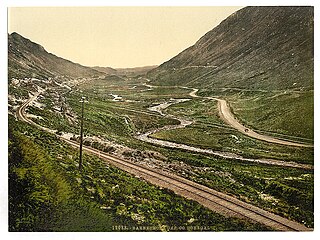
Barnesmore Gap is a mountain pass or gap situated in the Bluestack Mountains, County Donegal, Ireland. The main Donegal to Ballybofey road, the N15, and route of the former County Donegal Railway run through Barnesmore gap, acting as the main route between south and north Donegal. It is an area of complex geology, but its main feature is granite formed in the Devonian period, 400million years ago. The gap held glaciers in the Last Glacial Period flowing to the Atlantic through what is now Donegal Bay, up to about 13000 years ago. According to a 17th century Hiberno-Latin history of Donegal Abbey, the Gap of Barnesmore was once home to a large population of wild red deer.
The Donegal Senior Football Championship is an annual football competition organised by Donegal GAA and contested by the highest-level clubs, to determine the best team in County Donegal. Since 2016, it has been known as Michael Murphy Sports and Leisure Donegal SFC after its headline sponsor.
The Donegal Post is a local weekly regional newspaper published in County Donegal, Ireland. When the paper was first launched by River Media in June 2006, it served the area of south County Donegal, west County Fermanagh, north County Leitrim and north County Sligo.

Pearse Daniel Doherty is an Irish Sinn Féin politician who has been a Teachta Dála (TD) for the Donegal constituency since the 2016 general election, and previously a TD for the Donegal South-West constituency from 2010 to 2016. He also previously served as a Senator for the Agricultural Panel from 2007 to 2010.
Donegal West was a parliamentary constituency represented in Dáil Éireann, the lower house of the Irish parliament or Oireachtas from 1937 to 1961. The constituency elected 3 deputies to the Dáil, on the system of proportional representation by means of the single transferable vote (PR-STV).
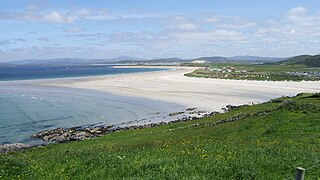
Narin, also Naran, is a small seaside village and townland in the parish of Ardara on the southwest coast of County Donegal, Ireland. The topography is rough rolling bogland and craggy low hills. Narin Strand is a sand beach approximately two kilometres long. Inishkeel island is located approximately 250 metres from the mainland in Gweebarra Bay and can be reached on foot at low tide by crossing a tidal sand bank. The population of Narin is spread sparsely around the countryside in mostly modern housing. There is a large tourist trade served by several bed and breakfasts and caravan parks. Local amenities consist of a pub, coffee shop and public toilets. There is also an 18-hole golf links with club house. Narin lies at an altitude of 12 metres and lies 8 km north of Ardara, 11 km northwest of Glenties and 13 km south of Dungloe. Brendan Behan stayed with his wife in Narin in 1961, where they spent much time swimming.

Naomh Conaill CLCG is a GAA club for the Glenties parish in south-west County Donegal. As well as the town of Glenties, the club also covers the area to the village of Fintown and the areas of Kilraine, The Glen and Maas down to the Gweebara Bridge. Much of this area lies within the Donegal Gaeltacht area.

Banagh is a historic barony in County Donegal in Ireland. Patrick Weston Joyce said the name Banagh came from Enna Bogaine, son of Conall Gulban, son of Niall of the Nine Hostages. It was created along with Boylagh when the former barony of Boylagh and Banagh was split in 1791 by an Act of the Parliament of Ireland.

The Bluestack Way is a long-distance trail through the Bluestack Mountains in County Donegal, Ireland. It is 65 kilometres long and begins in Donegal and ends in Ardara. It is typically completed in three days. It is designated as a National Waymarked Trail by the National Trails Office of the Irish Sports Council and is managed by the Bluestack Way Management Committee.
The 2012 All-Ireland Football Final, the 125th event of its kind and the culmination of the 2012 All-Ireland Senior Football Championship, was played at Croke Park, Dublin, on 23 September 2012. Donegal and Mayo, widely considered "one of the most novel final pairings of all time", met to decide the destination of the Sam Maguire Cup, with Donegal ultimately emerging victorious as Mayo were yet again undone by "the curse".
The Donegal Railway Company (DR) was a 3 ft gauge railway in Ireland.
The 2014 Donegal Senior Football Championship was the 92nd official edition of the Donegal GAA's premier club Gaelic football tournament for senior graded teams in County Donegal.
Ballybeg, an anglicisation of the Irish language name Baile Beag meaning "Little Town", is a fictional town in which Irish playwright Brian Friel set many of his works. Several of Friel's plays, including Philadelphia Here I Come!, Translations and Dancing at Lughnasa, are set in the fictional County Donegal town. Friel's Ballybeg is partially based on the real village of Glenties, close to where he lived.
